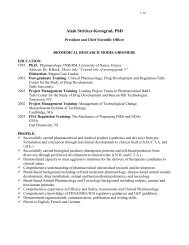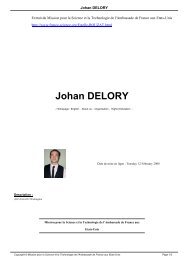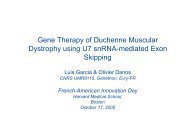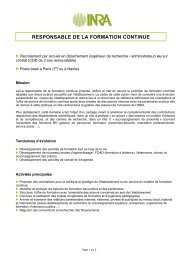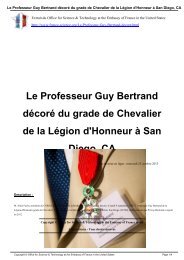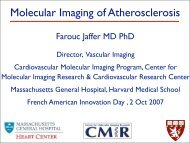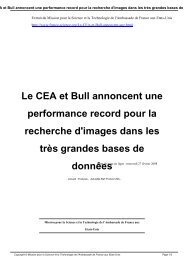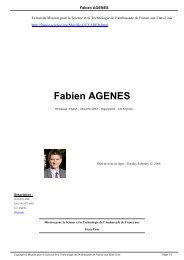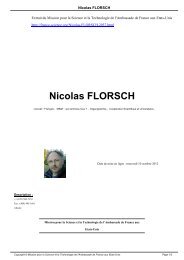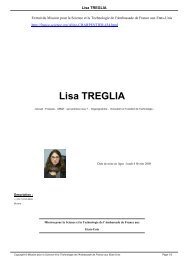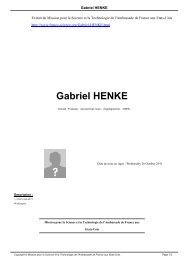Dr. Zahi FAYAD
Dr. Zahi FAYAD
Dr. Zahi FAYAD
- No tags were found...
Create successful ePaper yourself
Turn your PDF publications into a flip-book with our unique Google optimized e-Paper software.
Imaging Atherosclerosis<strong>Zahi</strong> A. Fayad, PhD, FAHA, FACCProfessor of Medicine (Cardiology) and RadiologyDirector, Translational and Molecular Imaging InstituteMount Sinai School of Medicine, New York, NY
From Anatomy to MoleculesMolecular / cellularprocessesAlterations of tissuemicrostructureQuantitative Mapping- Early Diagnostics (premorbid)- Therapy development (biomarker fordrug efficacy, safety, and mechanismof action)- Patient stratification and monitoringIn VivoMRI/Nuclear/CT/OpticalMacroscopic changesIn tissue morphologyPhysiological andMetabolic alterations
Molecular Imaging of AtherosclerosisPlaques: Multimodality Imaging ApproacChoudhury RP, Fuster V, FayNat Rev <strong>Dr</strong>ug Discov 2004
Motivation and BackgroundPET/CT Detection of PlaqueTheoryHigh risk plaquesActive macrophagesHigh metabolic activityHigh glucose uptake18FDG (glucose analog) Uptake Reflects GlycolysisHigh FDG uptake•Perhaps the best clinically (human) available today method is18F-FDG- Positron Emission Tomography
Rationale and BackgroundPrevious StudiesPET/CT Detection of Plaque2002: FDG-PET used to detect high risk plaque- patients with recent TIA: ipsilateral 18 FDG uptake > contralateral uptake- 18 FDG-PET/CT identified culprit lesion (Rudd et al)2004-2006:18FDG uptake correlated with macrophage content-Rabbit aortas (Ogawa 2004, Tawakol 2005, Zhang 2006)-Human Carotids (Tawakol 2006)2006: FDG-PET used to detect response to Tx-Lower 18 FDG uptake in subjects on 3 months of statins vs. placebo(Tahara et al)2007: FDG uptake correlated with CV risk factors-correlated with MMP-1 (Wu et al)-correlated with metabolic syndrome (Tahara et al)ut further validity studies – especially across multiple centers - need to be done
FDG Uptake (TBR) vs. Plaque ContentTawakol A. et al. JACC 2006; 48:1818-24
Complex carotid plaque bilaterally on MR –Bilateral FDG uptake right > leftMinor plaque on MR - High FDG uptake on PET
Dynamic Contrast Enhanced (DCE) MRI (Gd) and 18F-FDG-PET/CT inAtherosclerotic Rabbits Correlate Both with Neovessels ContentDCE-MRI SI Area Under the Curve (AUC) CD31 neovessels stainR = 0.73, P=0.096R = 0.52, P=0.004Calcagno C; Cornilly JC; Hyafil F; Rudd J; Fuster V; Fayad ZA et al.
Inflammation and Atherosclerosis: Correlation between Dynamic ContrasEnhanced (DCE) MRI (Gd) and 18F-FDG-PET/CT in Patients withAtheroscleroticre-contrast Post-contrast 2 min Post-contrast 8 min
8% decFDG-PET/CT in Carotid/Aortic PlaquesRegression Detected @ 3 monthsBaselineFollow-UpDietStatin43 pts Tx 5-20 mg simvastatin and diet for 12 weeks compared to diet aloneTahara et al J Am Coll Cardiol 20
Specific Aim 1: Results18FDG-PET/CT Reproducibility in Carotid Arteryn = 2210.90.80.7> 0.8: excellentagreementICC0.60.50.40.30.20.1Test-RetestIntraobserverInterobserver0Left CarotidRight CarotidBland Altman Plot: no systematicData is reproducible in carotidsudd JH et al. JACC 2007 in press
Inter-Scan VariabilityMean TBR21.81.61.41.210.80.60.40.20Left iliac scan 1Left iliac scan 2Right iliac scan 1Right iliac scan 2Left CFA/SFA scan 1Left CFA/SFA scan 2Right CFA/SFA scan 1Right CFA/SFA scan 2Left carotid scan 1Left carotid scan 2Right carotid scan 1Right carotid scan 2
Atherosclerotic Inflammation is highly correlated acrossvascular bedsAscendingArchDescendingAbdominalCarotidIliacFemoralAscending_r=0.88r=0.84r=0.88r=0.61r=0.79_Arch_r=0.81r=0.89r=0.64r=0.84_Descending___r=0.89r=0.48r=0.78_Abdominal____r=0.62r=0.86_Carotid_____r=0.57r=0.43Iliac______r=0.71Femoral_______• Inflammation in one artery is highly correlated with inflammation elsewh• Underpins the theory that atherosclerosis is a multi-region condition
Coronary Plaque w F18-FDG PET-CTHigh FDG uptake in myocytesTBR very lowDunphy and Strauss JNM
Delivery of contrast agentsSensitivityPET MRI CTradioactive paramagnetic radiodensePayload required
HIGH PAYLOAD!CANDY DELIVERYCHLOÉ
Plaque Classification by 16-slice CTin Human Coronaries Compared to IVUSHU850Mean: 361mean: 361CT77069061053045037029021013050Noncalcified Plaque/ “Soft“; “lipid rich plaque“ Plaque??Different elements may have same CT number!OVERLAP OF HUMean: 49 Mean: 91mean: 49 mean: 91-30Soft Fibrous CalcifiedLeber A et al JACC 2004Leber A; Fayad ZA et al JACC 2006 37% interobs. variability plaque volume (MDCT 64)IVU
Viles-Gonzalez JJ; Fayad ZA et al. Circulation. 2004;110:1467-1472
Non Ionic Iodinated CM: Clinically Used for Stenosis3 I per molecule,high concentration (2.4 mol I/L)good x-ray absorptionOOONCoronary stenosis imOIIOONNOIO
Targeted CT Contrast Agent :<strong>Dr</strong>ug ScaffoldSpacerO OMetabolicallySusceptibleGroupOIIOH 3 CNNCH 3HIH6-ethoxy-6-oxohexyl 3,5-bis(acetylamino)-2,4,6-triidobenzoate
Targeted CT Contrast Agent:N1177OOCH 3H 3 COINOOINOCH 3N1177 • nanosuspension• insoluble iodinated CT agen• lipid coated• 300 nm diameter• MW ~756 da• ester bond cleaved by MacHIH6-ethoxy-6-oxohexyl 3,5-bis(acetylamino)-2,4,6-triidobenzoateHyafil F et al. Nature Med 2007
Uptake of N1177 in macrophages in vitr Significant higher uptake of N1177 vs. conventional CT contrastagent after 1 hour incubation at 1 mg iodine /ml with macrophages(4920 ± 1019 vs. 55.6 ± 11.1 µg iodine/g wet weight )N1177IopamidolHyafil F et al. Nature Med 2007 (April in press)
Detection of macrophages in aortic atherosclerotic plaques ofhypercholesterolemic rabbits with the novel contrast agentN1177 and a clinical 64-slice CTFused MPR ofangiography aBefore injection During injection 2 hours after N1177 2-hour acquisitMacrophage immunostainingTransmission EMHyafil F et al. Nature Med 2007;13:636-641Absorption spectrum on Scanning EM
Quantification of the enhancement in the aortic wall on CTafter injection of contrast agentHounsfieldunits252015105*N1177Iopamidol* p < 0.050AtheroscleroticplaquesControlaortic wall
Atherosclerotic NZWR – 2 diff. levelsRAM-FDG PET/CTLevel ALevel BCT-N1177Level ALevel B
Both N1177 and FDG uptake correlate with aorticmacrophage infiltration50r=0.62, p=0.0010.8450.7N1177 enhancement (HU)403530252015105r=0.63, p=0.0010.60.50.40.30.20.1FDG uptake (SUV)00.00.00 0.20 0.40 0.60 0.80 1.00 1.20 1.40 1.60 1.80Macrophage content (% area)
Aortic FDG uptake correlates withN1177 CT enhancement25r=0.61, p=0.001N1177 enhancement (HU)201510500.15 0.25 0.35 0.45 0.55 0.65 0.75 0.85FDG Uptake (SUV)
Modified from Ralph WeissledRationale for Use of Iron-Based ImaginDetection thresholdsGd-chelateSPIO-nanoparticleRadioisotope10 -4 10 -6 10 -8 10 -10Tissue concentration (M)
Figure 1: USPIO induced SI loss in subendothelial fibrous cap region. (a) Pre image. (b) Post USPIOinfusion SI loss in peri-luminal region (arrowhead). (c) Matched Perls-stain showing correspondinglocation of USPIOs within fibrous cap region (arrowhead).Figure 2: Axial MR images through the commoncarotid artery post. Diffuse SI loss pre UPSIO injection(a) and ©. Focal SI loss observed 36 hours afterinfusion (b) and (d), *marks the lumen.Trivedi RA, Mallawarachi C, U-King-Im JM et al., ATVB 2006; 26:1601-1606
(A,B) MSR-targetemicelles (0.016 mmGd/kg)(C) untargetedmicelles (0.016 mmGd/kg)argeted particlesMacrophage Scavenger receptor-targeted Gd-micellesAnti-CD-204(D) Gd-DTPA (0.1mmol Gd/kg)Amirbekian V; Fayad ZA et. al. Proc Natl Acad Sci USA 2007;104:961.
im 3: Targeted particlesMSR-targeted mixed micelles: In vivo efficacyACEBDFA) The blue represents DAPI staining for nuclei (upleft).B) Fluorescently-labeled (NBD) immunomicelles(green color)C) Anti-CD68 stained macrophages (red)D) Areas of yellow represent overlap of labeledimmunomicelles and macrophages.E) Trichrome and (F) DIC light microscopy imagesthe sections above.Amirbekian V; Fayad ZA et. al. Proc Natl Acad Sci USA 2007;104:961.
Macrophage-Specific Immunomicelles Improve MRI DetectionCharacterization of Human AtherosclerosisNBD=green, anti-CD68=red, DAPI=blueA = control (non-fluorescent micelles)B=NBD-labeled micellesC=NBD-labeled Fc-micellesD= NBD-labeled immunomicelles (CD36)Lipinski MJ et al
DL as platform for Contrast Agent Delivery and Molecular Imaging• Are not recognized by the RESNative ApoA1• Lipoprotein carrier• Natural affinity to plaques (ap• Small size (7-12 nm)• Does not trigger immune react• Easily reconstituted• Biodegradable• Efficient drug carrier• Protective• Can be reroutedFrias, J. C. et al. Nano Lett. 2006, 6, 2220Frias, J. C. et al. J. Am. Chem. Soc. 2004, 126, 16316
Gd-HDL Peptide Mimetic 18A-Pro-18A• 18A-Pro-18A is anamphiphatic alpha-helix that iswell established to mimic theproperties of ApoA-118A(37pA is 18A-P-18A)
Confocal MicroscopyA – nuclei stained by DAPIB – Rhodamine from agent 1C – Alexa647:CD68 staining ofmacrophagesD – superimposition of A, B and Ctargets macrophages in the plaqueMRI
Different types of particle may be incorporated into HDL
High-Risk Plaque BioImage Study•To identify non-invasive imaging and/or circulating HRPbiomarkers that predict 3-year cardiovascular eventswith superior specificity and sensitivity over Framingham risk scoreScan subjects on mobile unitsUS3T MRCTPET/CT• Representative sample of intermediary riskpopulation recruited from Humana membership• Men 55-80, Women 60-80• N=7300 (6000 + 1300 w/o imaging)• Follow-up: 3-year event monitoring and bloodsample collection• Baseline evaluation in mobile laboratory for:– Signs, symptoms, risks and health status– Physical measurements (weight, height, BP, W2Hratio)– Baseline blood work and sample collection forstorage– Ankle Brachial Index– CT Calcium Score– Carotid US• Enhanced imaging studies for those who aredetermined high-risk based imaging risk scoring
Silvia Aguiar, MD Gilbert Aguinaldo, MD Vardan Amirbekian, MD Alessandra Barraza, PhD Anne Beilvert Anne Bystrup Claudia Calcagno, MD Wei Chen, PhD David Cormode, PhD Jean-Christophe Cornilly, MD Hamza El Aidi, MD Rima Fayad, MPH JC Frias, PhD Hanna Oltarzewska, RT Fabien Hyafil, MD Vitalii Itskovich, PhD Mark LobattoImaging Science Laboratories (ISL)Sinai Translational and Molecular Imaging Institute Michael Lipinski, MD Frank Macaluso, RT Venkatesh Mani, PhD Lena Mara Willem Mulder, PhD Kelly Myers Elana Pessin Sybil Price Dan Samber, MS Karen Saebo, PhD Stephane Silvera, MD Marc Sirol, MD James Rudd, MD, PhD Cheuk Tang, PhD Esad Vucic, MD Linda Yang, MD Karen Weinshelbaum Yu Zhou, PhD• NIH/NHLBI R01HL71021; R01HL78667; R43HL71470NIH/NCRR M01RR000071 (GCRC, Imaging Core) P20RR023502 (pre-CTSA)Collaborators/Support• Valentin Fuster, MD, PhD• Michael Farkouh, MD• Edward A. Fisher, MD, PhD (NYU)• Burton <strong>Dr</strong>ayer, MD• Mario Garcia, MD• Josef Machac, MD• Sameer Bansilal, MD• John Postley, MD• Eric Alder, MD• Emil Cohen, MD• Javier Sanz, MD• John Fallon, MD, PhD• Ash Rafique• Pedro Moreno, MD• Yukihiko Momiyama, MD (Tokyo)• Klaas Nicolay, PhD (Eindhoven)• Gustav Strijkers, PhD (Eindhoven)• Kevin Williams, MD (Jefferson)• Silvio Aime, PhD (Torino)• Sam Tsimikas, MD (UCSD)• Margitta Dathe (Berlin)• Eik Leopold (Berlin)• Robin Choudhury (Oxford)• Ahmed Tawakol (MGH)



